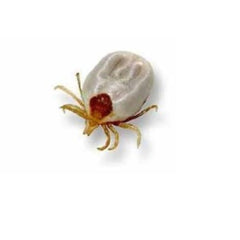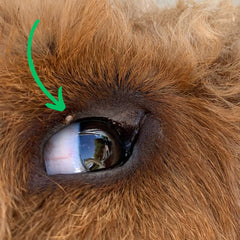
Are you worried about the health and safety of your furry best friend? With a shortage of anti tick serum nation wide, prevention is the best action when it comes to ticks! With the arrival of warmer weather, tick prevention becomes essential in safeguarding your dog from parasites like paralysis ticks. These tiny creatures may seem harmless, but they can pose a serious threat to your pet's well-being.
In this comprehensive guide, we will take you through the ins and outs of tick prevention. We'll explore the best methods to protect your dog, including topical treatments, tick collars, and regular tick checks. From understanding the signs of tick infestation to learning how to remove these pests safely, we've got you covered.
With years of experience in helping pet owners keep their dogs healthy, we ensure that our recommendations are based on scientific research and expert advice. By following our tips and implementing an effective tick prevention routine, you can give your canine companion the best chance at a tick-free life. Don't let paralysis ticks put your dog's health at risk - join us on this journey as we learn how to protect our furry friends together.
Understanding paralysis ticks and their dangers
 Paralysis ticks (Ixodes holocyclus) are small arachnids that are prevalent in Australia's eastern coastal regions. These ticks are notorious for causing paralysis in dogs, which can be fatal if not treated promptly. The female paralysis tick attaches itself to the host and releases a potent toxin while feeding on the host's blood. This toxin affects the nervous system, leading to muscle weakness, difficulty breathing, and eventually paralysis.
Paralysis ticks (Ixodes holocyclus) are small arachnids that are prevalent in Australia's eastern coastal regions. These ticks are notorious for causing paralysis in dogs, which can be fatal if not treated promptly. The female paralysis tick attaches itself to the host and releases a potent toxin while feeding on the host's blood. This toxin affects the nervous system, leading to muscle weakness, difficulty breathing, and eventually paralysis.
It's crucial to understand that paralysis ticks are not limited to rural areas. They can be found in urban environments as well, hiding in long grass, leaf litter, and even in your backyard. Therefore, no matter where you live, it's essential to take preventive measures to protect your dog from these dangerous parasites.
Signs and symptoms of paralysis tick poisoning in dogs
Identifying the signs and symptoms of paralysis tick poisoning is crucial for early detection and treatment. Keep a close eye on your dog and look out for the following symptoms:
1. Lethargy and weakness: A sudden lack of energy and strength may indicate paralysis tick poisoning. If your dog seems unusually tired and struggles to move, it's crucial to investigate further.
2. Altered breathing: Paralysis ticks can affect the muscles responsible for breathing, leading to coughing, wheezing, or labored breathing. If your dog shows any signs of respiratory distress, seek veterinary assistance immediately.
3. Change in vocalisation: Dogs affected by paralysis ticks may develop a hoarse or weak voice due to the impact on their throat muscles.
4. Vomiting or regurgitation: Paralysis ticks can cause gastrointestinal issues, leading to vomiting or regurgitation.
5. Loss of coordination: As paralysis progresses, dogs may lose their coordination, stumbling or swaying when trying to walk.
It's important to note that symptoms can vary from dog to dog, and some dogs may not show any signs until the paralysis is advanced. Regular tick checks and preventive measures are crucial to avoid tick infestations and reduce the risk to your dog's health.
The importance of tick prevention for your dog's health
Tick prevention is paramount when it comes to your dog's health and well-being. The consequences of paralysis tick infestation can be severe, leading to respiratory failure and, in some cases, death. Prevention is always better than cure, and by taking proactive steps to protect your dog, you can avoid the potentially devastating effects of tick poisoning.
Tick prevention not only safeguards your dog's health but also saves you from expensive veterinary bills and emotional distress. By investing time and effort into tick prevention, you can provide your furry friend with a happy and healthy life, free from the dangers posed by paralysis ticks.
Tick prevention methods and products
Fortunately, there are several effective methods and products available to prevent tick infestation in dogs. Here are some popular options to consider:
1. Topical treatments: Applying tick prevention spot-on treatments directly to your dog's skin is a common and effective method. These treatments typically contain acaricides that kill ticks upon contact. Ensure you choose a treatment specifically formulated for dogs, as some tick preventives for other animals can be toxic to dogs.
2. Tick collars: Tick collars are another popular preventive measure. These collars release chemicals that repel and kill ticks, providing continuous protection for several months. However, it's important to follow the manufacturer's instructions and check for any potential adverse reactions to the collar. We recommend using Seresto tick collars in conjunction with a flea and tick preventative product such as Simparica Trio or Nexgard Spectra.
3. Oral medications: Oral chews are a convenient option for tick prevention. These tablets or chews contain chemicals that kill ticks when ingested by your dog. Oral preventives are highly effective and provide systemic protection against tick infestation.
4. Tick sprays: Tick sprays can be used as an additional preventive measure, especially when venturing into tick-prone areas. These sprays create a protective barrier on your dog's coat, repelling ticks and preventing them from attaching.
It's important to consult with your veterinarian to determine the most appropriate tick prevention method for your dog. Factors such as your dog's breed, age, health condition, and lifestyle will influence the choice of preventive measures.
Tick checks and grooming practices to prevent tick infestations
 Regular tick checks and grooming practices play a crucial role in preventing tick infestations. Here are some tips to help you keep your dog tick-free:
Regular tick checks and grooming practices play a crucial role in preventing tick infestations. Here are some tips to help you keep your dog tick-free:
1. Daily tick checks: Perform a thorough tick check on your dog's entire body, including the ears, paws, and between the toes. Run your hands through your dog's fur, feeling for any bumps or lumps. Pay close attention to areas where ticks commonly hide, such as the lips, ears, eyelids, neck, armpits, and groin.
2. Tick removal: If you find a tick attached to your dog, it's important to remove it promptly and safely. Use tweezers or a tick removal tool to grasp the tick as close to the skin as possible and gently twist the tick in a clockwise or anticlockwise direction and pull the tick up away from the animal’s skin. Avoid squeezing the tick, as this can increase the risk of toxin release.
3. Regular grooming: Regular grooming helps keep your dog's coat clean and free from ticks. Brushing your dog's fur helps you spot any ticks that may be hiding. Additionally, bathing your dog with a tick-repellent shampoo can provide a small layer of protection.
4. Maintain a tick-free environment: Keep your surroundings clean and free from tick habitats. Regularly mow your lawn, remove leaf litter, and trim shrubs to reduce tick populations in your yard.
By incorporating these practices into your routine, you can significantly reduce the risk of tick infestation and keep your dog safe and healthy.
Common misconceptions about tick prevention
There are several misconceptions surrounding tick prevention that can hinder your efforts to protect your dog. Let's debunk some of these myths:
1. Myth: Natural remedies are sufficient: While natural remedies may have some repellent properties, they are generally not as effective as veterinarian-recommended preventives. It's important to rely on scientifically proven methods to ensure your dog is adequately protected.
2. Myth: Tick preventives are only necessary during tick season: Tick season may vary depending on your location, but it's important to provide year-round protection for your dog. Ticks can still be active during cooler months, especially along the east coast of Australia and it's best not to take any chances.
3. Myth: One tick preventive method is enough: Combining multiple preventive methods such as a tick collar and a monthly chew can provide enhanced protection for your dog. Talk to your veterinarian about the best approach for your pet's specific needs.
Keeping your dog safe from paralysis ticks
Protecting your dog from paralysis ticks is of utmost importance to ensure their well-being. By understanding the dangers posed by these parasites, recognising the signs of tick poisoning, and implementing effective preventive measures, you can significantly reduce the risk to your furry friend.
Remember to consult with your veterinarian to determine the most suitable tick prevention method for your dog. Regular tick checks, grooming practices, and maintaining a tick-free environment are vital components of a comprehensive tick prevention routine.
Don't let paralysis ticks compromise your dog's health and happiness. Take action today and embark on the journey of safeguarding your beloved pet from these dangerous parasites.
©deliveryhound.com.au 2023






